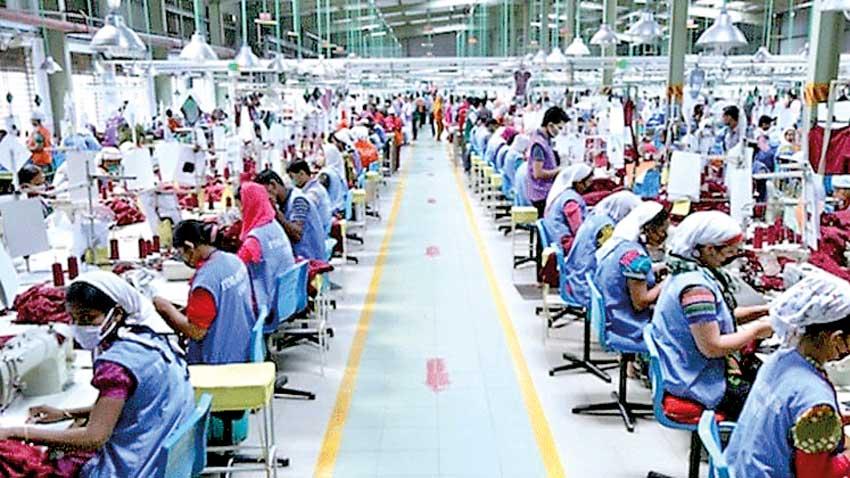20 May 2020 - {{hitsCtrl.values.hits}}

By Nishel Fernando
The world’s biggest narrow fabric and elastics supplier to the garments industry, Stretchline Holdings, of which Sri Lanka’s MAS Holdings is a joint venture partner, has announced a voluntary retirement scheme (VRS) at one of its plants in Sri Lanka, as the apparel exporters renew the call to the government to amend the existing labour laws to allow a 30 percent cut in employment, to survive during the COVID-19 crisis period.
Stretchline Holdings early this week announced a VRS for 100 employees from executive level and above for its plant in the Biyagama Industrial Zone, according to company sources.
The move is said to be part of Stretchline’s on-going restructuring process, although it is also aimed at preserving cash to manage the impact from the COVID-19 pandemic, which has caused large-scale cancellations and postponing export orders by global retailers.
Stretchline generates around US $ 30-40 million turnover per annum.
However, an official of MAS Holdings said that the group doesn’t intend to roll out such schemes and other top apparel exporters shared similar sentiments.
MAS Holdings has already announced pay cuts in the range of 5-60 percent for its executive cadre. Similar pay cuts have also been implemented by other top apparel exporters, while most SME apparel manufactures had been unable to pay the salaries for their employees beyond the month of March.
Speaking to Mirror Business, Sri Lanka Apparels Exporters Association Chairman Rehan Lakhany stressed that a minimum 30 percent laying off of employees in the sector is crucial for the apparel exporters, to remain afloat during the crisis period and to avoid a potential collapse of the industry.
“That’s why we are requesting the government to amend the current labour laws for the industry to survive through this crisis period. We are asking the government to allow us to lay off at least 30 percent of employees, so that the employments of balance 70 percent can be safeguarded. If the industry doesn’t survive through this period and the industry collapses, all employments could be lost,” he warned.
Further, he lamented that 95 percent of the exporters are still struggling to obtain the concessionary working capital loans announced by the government, which were to be disbursed by the banking sector.
“The conditions that are imposed by these banks to disburse the requested loans are almost impossible to fulfil. They are seeking collateral and so many other requirements. So far, about 95 percent firms, who applied for the loan scheme, have not been able to obtain these loans. Therefore, we are asking the government to have a relook at the conditions that are imposed upon the disbursement of these loans,” he pointed out.
Overall, the apparel exporters remain dissatisfied with the government support extended so far to the industry, which remains unsubstantial, compared to the support extended by the governments in competitor nations with various fiscal measures.
“We don’t have any positive outcomes yet. When you look at our competitors, such as Bangladesh, Cambodia, Vietnam or even India and Ethiopia, they have come up with huge stimulus packages for their apparel sectors.
Unfortunately, the Sri Lankan apparel exporters are yet to see any stimulus,” Lakhany noted.
Although several apparel exporters have moved into production of personal protective equipment (PPE) to recover their costs and to maintain a cash flow, he pointed out that they are still incurring operational losses as their revenues are not sufficient to cover the fixed costs.
“Even plants that have commenced operations can only operate at a maximum capacity of 50-60 percent, which means they continue to make losses until they can run at 95-100 percent capacity. The factories would only operate at a partial capacity due to the health guidelines and social distancing as well as order cancellations,” he pointed out.
Further, he opined that the most of the industry players would be forced to focus on their regular orders in a little over a month, as there could be an oversupply of PPE in the world market by end-June.
“I think we have to get back to regular orders from end of June; we will run out of PPE orders, that’s when the industry really has to face difficulties,” he added.
Some leading exporters expect that the industry would see some recovery in orders only from August this year with several leading retailers in the United States (US), such as JC Penny, Neiman Marcus and J. Crew, already filing for bankruptcy.
Although, there is an increasing number of opportunities for Sri Lanka’s apparel exporters in the medium to long term, as the brands look to diversify their production base, moving away from China, Lakhany asserted that it’s crucial for the industry to survive during the next couple of painful months to capitalise on these opportunities by staying afloat.
“It will be a slow and gradual move; it will take some time for some orders to move out of China. We hope that it will help the Sri Lankan manufactures in the long term. We need the industry to survive during the short term in order to capture these opportunities. If the factories go bankrupt during the current crisis, it would be difficult to take the advantage of these opportunities,” he elaborated.
Sri Lanka’s apparel exports are estimated to decline by US $ 1.5 billion this year to reach US $ 3.5 billion in the best case scenario, compared to US $ 5.3 billion earnings last year.
15 Nov 2024 7 hours ago
15 Nov 2024 9 hours ago
15 Nov 2024 15 Nov 2024
15 Nov 2024 15 Nov 2024
15 Nov 2024 15 Nov 2024